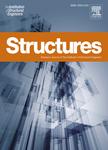版权所有:内蒙古大学图书馆 技术提供:维普资讯• 智图
内蒙古自治区呼和浩特市赛罕区大学西街235号 邮编: 010021

作者机构:Indian Inst Technol Mandi I4S Lab Mandi HP India
出 版 物:《STRUCTURES》 (Structures)
年 卷 期:2024年第62卷
核心收录:
主 题:Damage detection Finite element model Mass-less rotational spring Model-based algorithm Hybrid interacting Particle-Kalman filter Structural health monitoring
摘 要:Monitoring the health of large-scale infrastructure with the required precision necessitates high-dimensional support models and extensive instrumentation. However, in a model-based structural health monitoring (SHM) framework, the ability to localize damage is constrained by the discretization of the model. To enhance the resolution of discretization, dense instrumentation is essential to address the inherent challenges in solving the inverse problem. Yet, increasing dimensionality can introduce detection delays, a critical concern in SHM. Additionally, addressing uncertainties stemming from the model, measurements, or external factors is crucial for reliable real-world SHM. This study focuses on localized damages, such as cracks, where detection precision is paramount. To tackle these challenges, this study proposes an innovative hybrid interacting Particle-Kalman filter (h-IPKF)-based SHM approach that surpasses model discretization limitations for detection resolution. This approach employs two distinct indices for crack localization: global (GDI) and local (LDI) damage indices. GDI identifies the affected element using a coarsely discretized predictor model, while LDI precisely pinpoints the crack location within the element. This paper represents the crack as a massless rotational spring with deteriorated stiffness (gamma) and parameterizes it using GDI, LDI, and gamma. Subsequently, the h-IPKF framework is employed to estimate the crack parameters, capable of handling both continuous and discrete random variables, which is advantageous for addressing discrete variables like GDI. Extensive numerical and real validation tests on beam structures were conducted to assess the algorithm s sensitivity to noise and damage severity, demonstrating its efficiency, promptness, and precision in detecting cracks within structures.